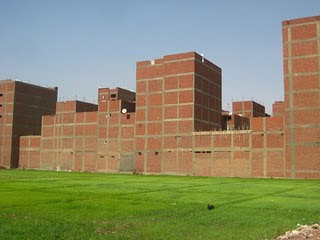Cairo. Revolutionary Change?
It has been extraordinary to watch the events in Egypt unfold in the last few days. In some ways, it is absolutely shocking to see the extent to which ordinary citizens have shed their fear of the government. Yet, on the other hand, it is amazing that it has taken this long. Having navigated the complete chaos of the city, visited and met citizens living in deep poverty and unimaginable living conditions, and finally watching new cities for the wealthy develop on the outskirts of Cairo, it became clear to me how broken Egyptian society had become.
Beverly Hills development on outside of Cairo
And while the society seemed broken, the culture and individual spirit was not. The capacity of the individual to operate in small moves against the larger forces of repression, poverty, and control felt like a mini-rebellion. And so much of this is represented physically in Cairo precisely by where and how people defined their living space. Some neighborhoods generate income by collecting and processing trash in their homes. Unregulated additions and extensions to apartments and public housing have helped people open businesses as well as generate a feeling of upward mobility. Finally, the extreme quest for space has generated some incredible spatial conditions. People found available and affordable space by living in tombs in the city’s largest cemetery while explosive transition of fertile Nile farmlands to vertical slums is one of the only ways the city can absorb the massive migration.
Giza
As the revolution progresses, it is clear that the physical design and condition of the city is having a significant effect on the protests, as well as what is being communicated to the outside world. In a great post on the Polis blog, Danya Al Saleh and Mohammed Rafi Arefin describe Cairo as much more than a stage for rebellion, but as a “tool for rebellion”, with the spaces of the city continually being contested by protestors and government forces. The sprawling boulevards and open spaces were “originally planned in the 1800s to monitor and limit such upheaval, the concentrically organized downtown modelled after the belle-epoque aesthetics of Paris imposed a sort of urban discipline that was to foster the creation of the "modern" and neatly "organized" Egyptian citizen.” In recent days, though, they have allowed a great gathering and convergence of people and voices. And yet, even with the digital space being tightly controlled and almost completely shut down by the government, we are able to watch the events unfold from the balconies of the thousands of apartment buildings that dot the areas. It is from these privelaged vantage points that we are able to witness history.
Tahrir Square, Ramses intersection and October 6th Bridge
But what about the rest of the city? In the neighborhoods where the majority of the Cairo’s citizens live, there are no wide boulevards and open spaces. The streets are often meandering labyrinths where only occasional daylight even penetrates. They may only have a few main entrances connecting to larger roads and thoroughfares. These are areas and neighborhoods that are anything but planned by outside agencies. They are self-planned and evolve incrementally in small moves, instead of large, grand sweeping ones. They are the antithesis of the space of revolution that we are witnessing in Cairo’s main spaces. Large tanks, police vans, and water cannons cannot move through these neighborhoods.
Al Dharb Al Ahmad
So, what is going on in these spaces? I have seen very few images, but have heard some disturbing reports. As night fell Friday, reports were that police were being far more brutal in denser neighborhoods where there were not watchful cell phones from up above. But, maybe the maze-like structure of the neighborhoods is actually beneficial to the inhabitants, as they are able to intimately negotiate the space that would be completely foreign to outsiders such as police.
Aerial, rooftop and street level of Manshiet Nasser
This morning, we awake to the news that the police have completely disappeared and that citizens are taking to protecting their own security, goods, and neighborhoods. Checkpoints have been set up to control access to such areas, and maybe in these cases, once again, the design and makeup of such “informal” communities is a benefit and asset. Ironically, these decentralized spaces have often been difficult to police and monitor by outside forces, and often develop deep community ties and relationships. And while the large revolution is being witnessed on the grand boulevards and central avenues, I really want to know what is happening in the small streets and massive slums of the city.
Downtown Cairo
Cairo, the collage-city, that is constantly adapting and changing, is forever altered. While the future of Mubarek remains very uncertain, so too does the makeup of the city and the design of the built environment. Previous changes have been relegated to large moves propogated by the rich and powerful, with very small moves necessitated by the poor and powerless, leaving a city that is anything but an example of "urban harmony". Will the fundamental shift in power that is playing out forever change the makeup and composition of Cairo? Could the future planning and design of Cairo shift to now potentially harness the incredible capacity of the average, ordinary people to bring about a more just city? Hopefully the answers to these questions will come without anymore bloodshed.












Comments
you have amazing website )))
Im working on a project about Sao Paulo and I would like to ask you a favour about your picture ))) Could you please contact me on as soon as pos.:
lucieste@gmail.com
thanks )))
Lucie